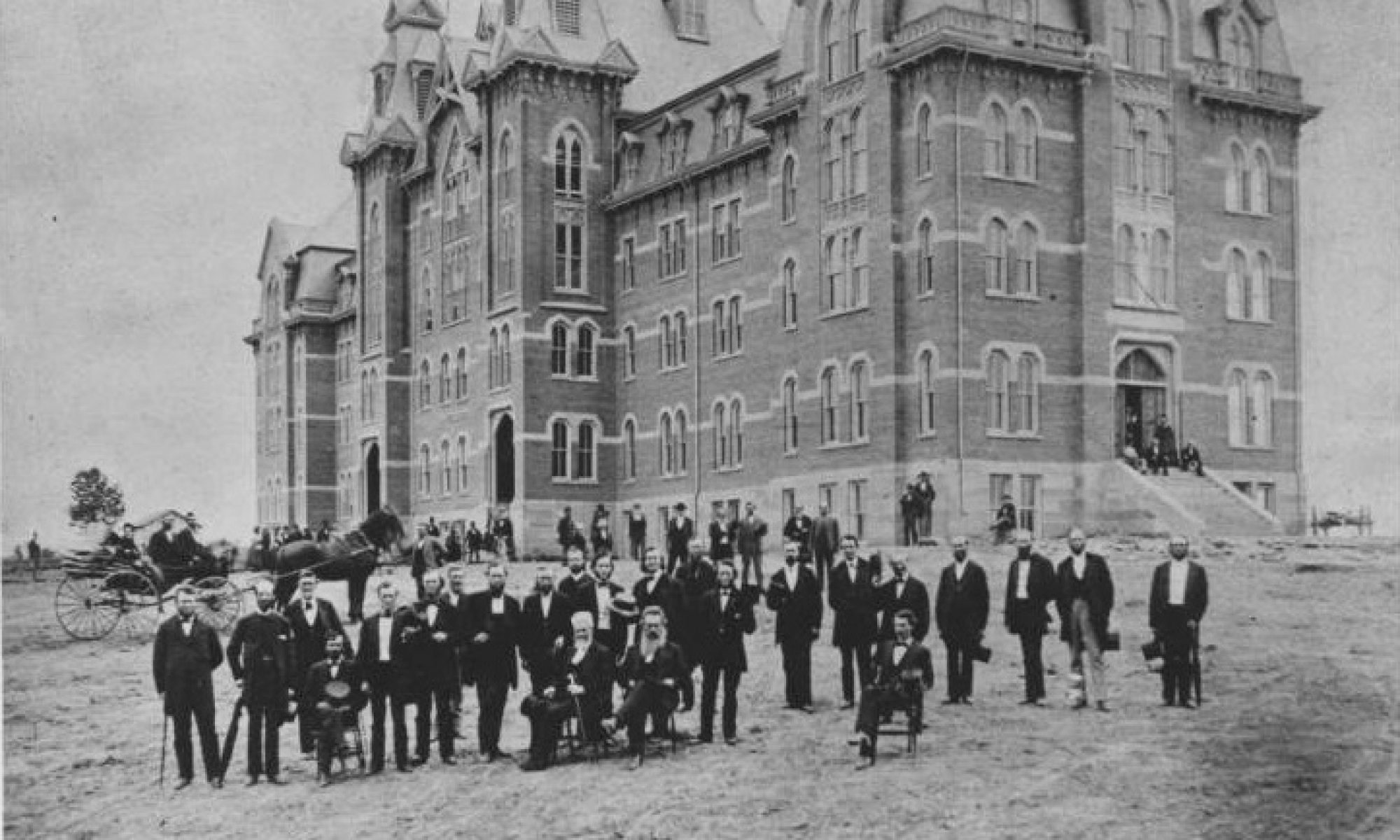Introduction | Buchtel Hall Takeover | Anti-Apartheid Protests | Protests for Equality | Conclusion
Buchtel Hall Takeover
In the fall of 1968, students at The University of Akron, led by United Afro-American Students, renamed Black United Students (BUS) in November 1969, were negotiating with the administration to create a Black Studies Program. Progress was made in the spring of 1969, including University Council approving the program in principle, President Norman P. Auburn appointing a Committee on Black Studies, and several courses in Black history and literature being planned for the fall and winter quarters. Additionally, over the summer, a coordinating committee was established and a director of the program was appointed that fall. However, members of BUS felt that the University’s response was not sufficient and was taking too long. Therefore, on December 8, 1969, the University received a list of demands from BUS.
Meetings to discuss the demands were held between the administration and BUS during final exams week, on December 8-9. The University presented a written reply to BUS on December 9 stating its position and requesting additional information. However, feeling further frustration, on December 10, around 10 a.m., six Black students “took over” Buchtel Hall, the University’s main administration building, and occupied it for three hours, with numerous staff and administrators inside. This was not the first “occupation” of an academic building by Black students in the country, however, as similar “takeovers” occurred at Columbia University in 1968, Duke University in February 1969, and Cornell University in April of that year. In fact, the takeover at UA might have been influenced by these events, in addition to deteriorating race relations in the country and in the city of Akron, especially the Wooster Avenue riots in the summer of 1968. This pivotal event in the University’s history that became known as “the Buchtel Hall Takeover” and its consequences are told below through historic photographs, documents, and newspapers from the time.

From The University of Akron Vertical File Collection in Archival Services of University Libraries
University President Norman P. Auburn appointed a committee of faculty and students in the Spring of 1969 to study the need for a Black Studies Program. These minutes record the discussions and decisions made during their first meeting. In attendance were University President Norman P. Auburn, Vice President for Academic Affairs Dr. Arthur K. Brintnall, Dean of Student Services Richard L. Hansford, Akron civil rights leader Vernon Odom, and BUS President Bruce Conley. These individuals would all play a role in the events that would unfold on December 10th.

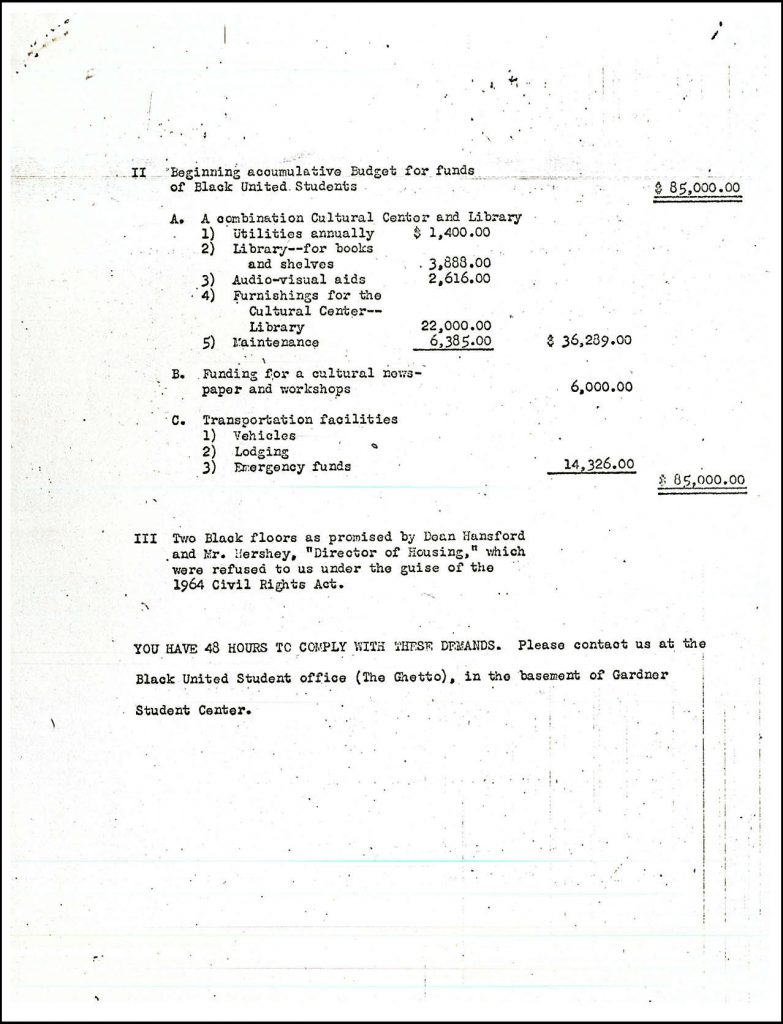
From The University of Akron Vertical File Collection in Archival Services of University Libraries
On December 8, 1969, this list of demands and associated expenses was delivered by representatives of BUS to vice presidents Arthur Brintnall and Richard Hansford. The demands, which the group later told the press were simply “requests,” called for half a million dollars for a Black Studies Program, $85,000 for BUS, including money for a Black cultural center and library, and two floors of a dormitory for Black students. The administration was given 48 hours to comply.
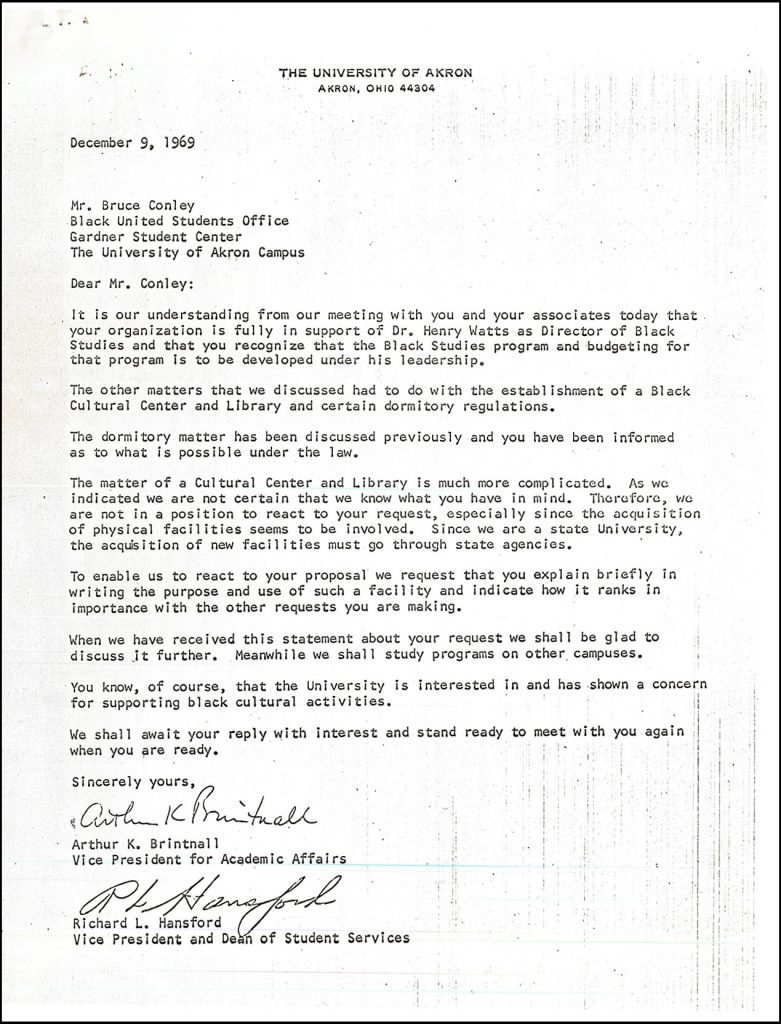
From The University of Akron Vertical File Collection in Archival Services of University Libraries
This letter signed by vice presidents Brintnall and Hansford was delivered to Bruce Conley at the BUS Office (known as “the ghetto” by BUS members) in the Gardner Student Center on the morning of the takeover. It attempts to address the demands submitted the previous day. However, BUS regarded the letter as a “slap in the face” and another deliberate delay tactic.

From The University of Akron Vertical File Collection in Archival Services of University Libraries
This policy statement was also delivered to Conley on the morning of the takeover. It outlines the University’s account of the meetings held between the administration and BUS representatives on December 8th and 9th. The handwritten note in the top left corner states that it was delivered by President Auburn to University Council on December 11th.
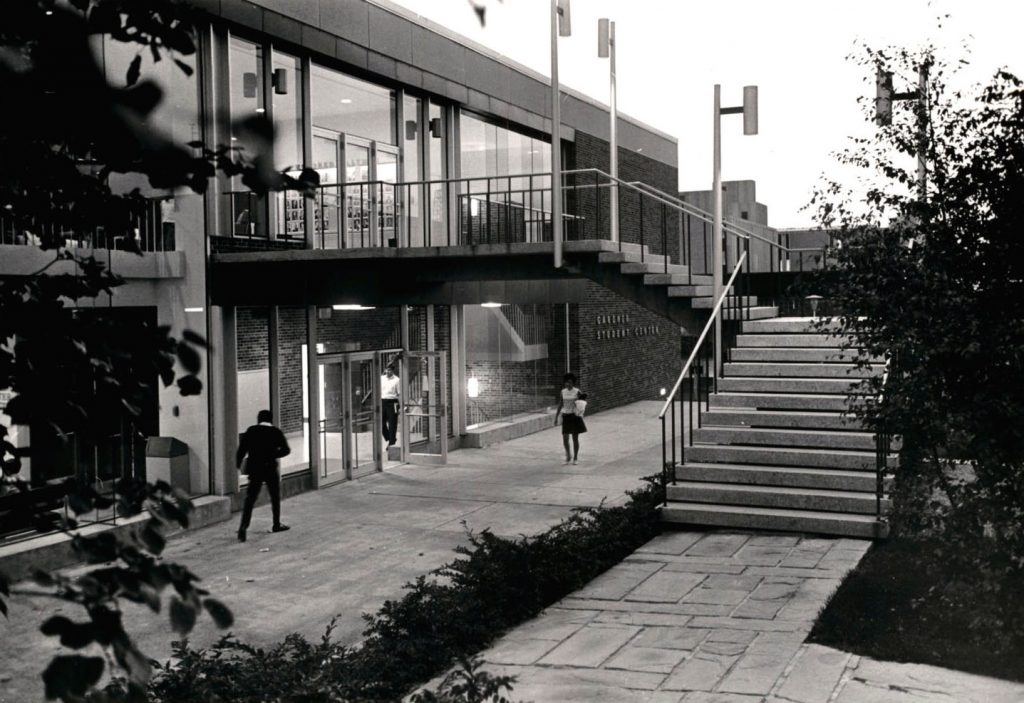
From The University of Akron Photographs Collection in Archival Services of University Libraries
Due to BUS’s dissatisfaction with the letter from Brintnall and Hansford, they decided to orchestrate a sit-in demonstration in this building, Gardner Student Center. The sit-in was initiated by pulling the fire alarm to evacuate the building, at which time members of BUS carrying protest signs re-entered the building and convened on the main floor. Later, at approximately 10 a.m., six BUS members left the Student Center and entered the back entrance to the adjacent Buchtel Hall.
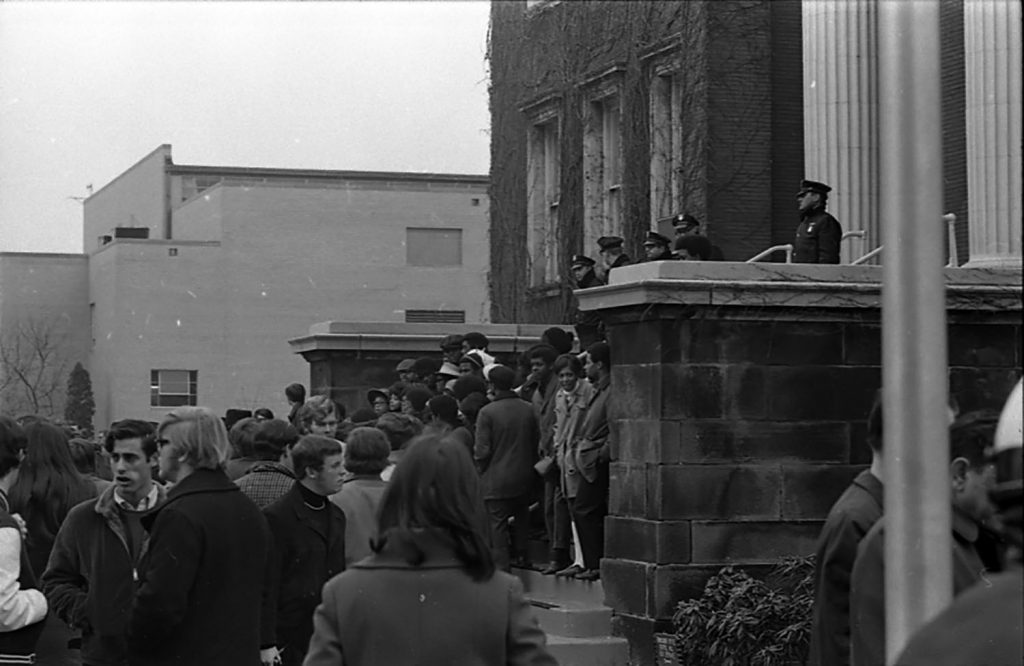
From The University of Akron Photographs Collection in Archival Services of University Libraries. Photo by Lew Tobias.
A crowd of students gather around the steps to Buchtel Hall as armed Akron City Police officers guard the doors to the building. It was reported that when the students seized the building around 10 a.m. they tied off or chained the doors and climbed the back stairway to the main lobby. Then, one of them fired three shots in the air in the hallway, purportedly blanks from an athletic starter’s gun.
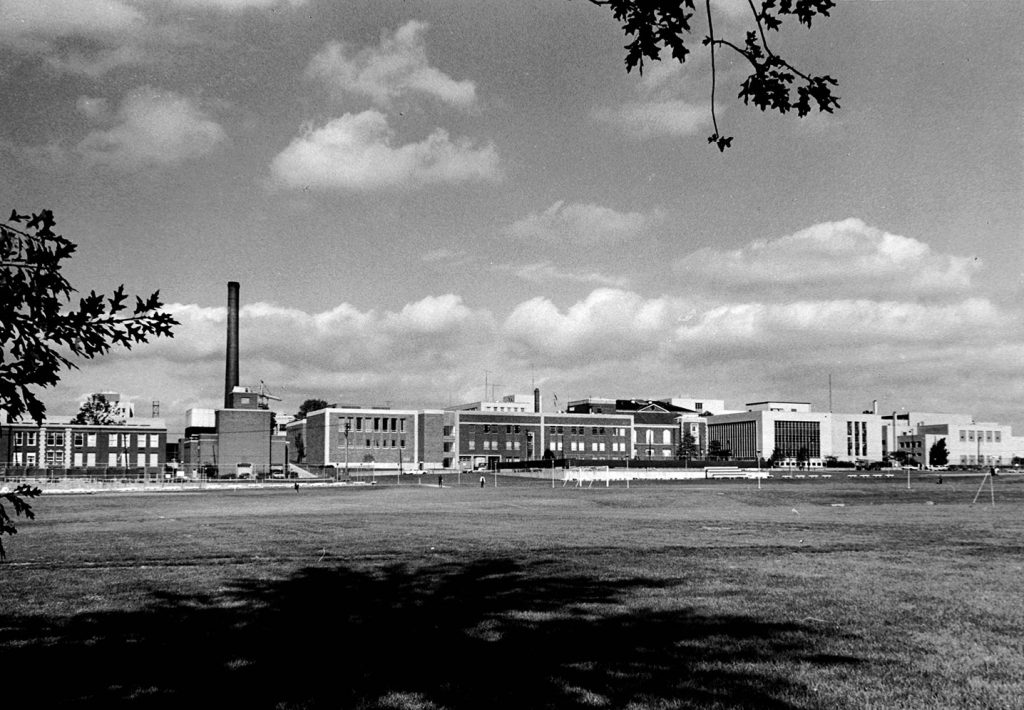
From The University of Akron Photographs Collection in Archival Services of University Libraries
At roughly the same time BUS members were occupying Buchtel Hall, fires were set across campus in Knight Hall, Simmons Hall (left), and the Business and Law Building (right). Fortunately, the fires were quickly extinguished and caused minimal damage. Authorities never determined who set the fires.
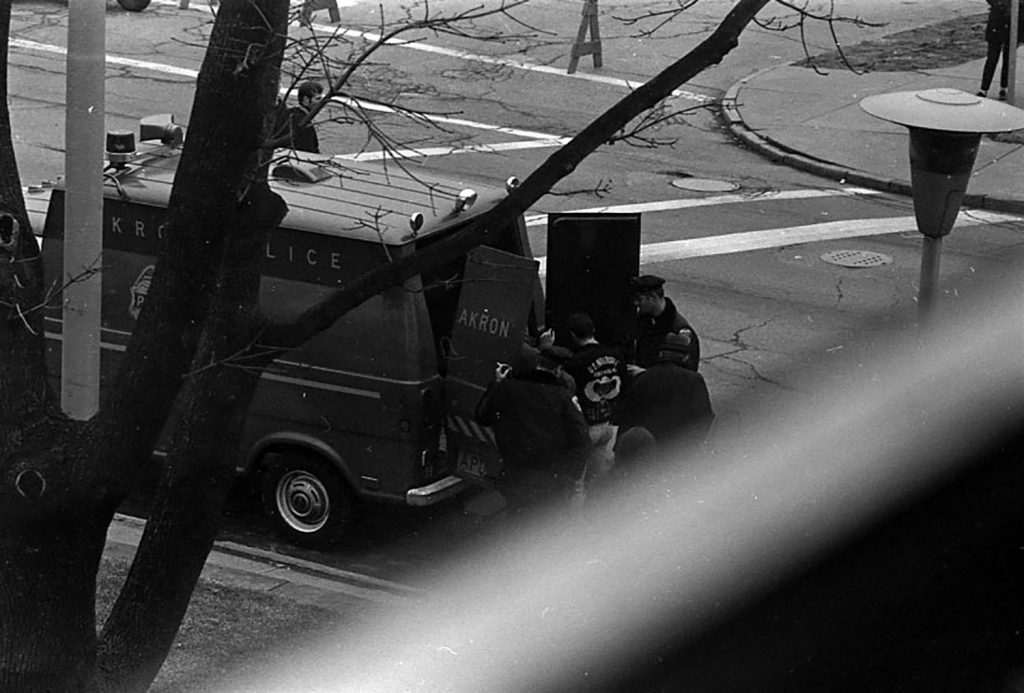
From The University of Akron Photographs Collection in Archival Services of University Libraries. Photo by Lew Tobias.
Shortly after the takeover started, approximately forty members of the Akron Police Department arrived on the scene. This Akron Police van is parked on Buchtel Avenue in front of Buchtel Hall. The street in the background is already barricaded by this time to keep traffic out of the vicinity.
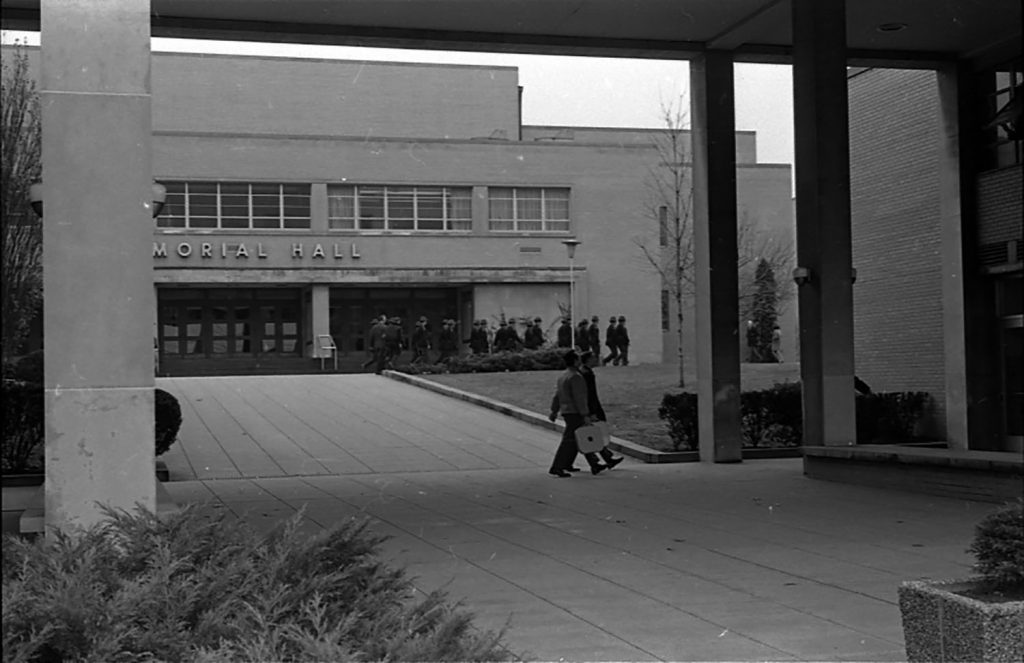
From The University of Akron Photographs Collection in Archival Services of University Libraries. Photo by Lew Tobias.
Shortly after Akron City Police arrived on campus, twenty members of the Ohio State Patrol arrived on the scene to help quell the situation. The State Patrol assembled at the Memorial Hall Gym and formation marched to the steps of Buchtel Hall, as seen in this image. Although Governor Jim Rhodes was contacted in Columbus and activated the National Guard, they were not dispatched to the campus, at President Auburn’s request.
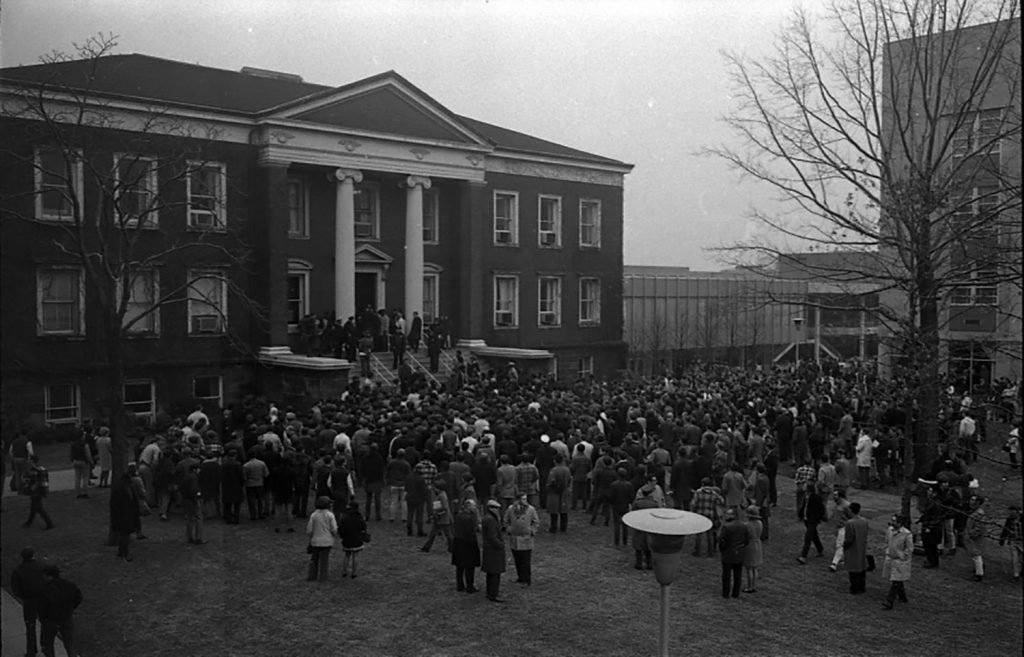
From The University of Akron Photographs Collection in Archival Services of University Libraries. Photo by Lew Tobias.
This photograph shows the size of the crowd on the lawn outside Buchtel Hall during the takeover. The College of Education (Zook Hall) can be seen to the right while Gardner Student Center can be seen in the background. The size of the crowd at this point numbered approximately 300 people.
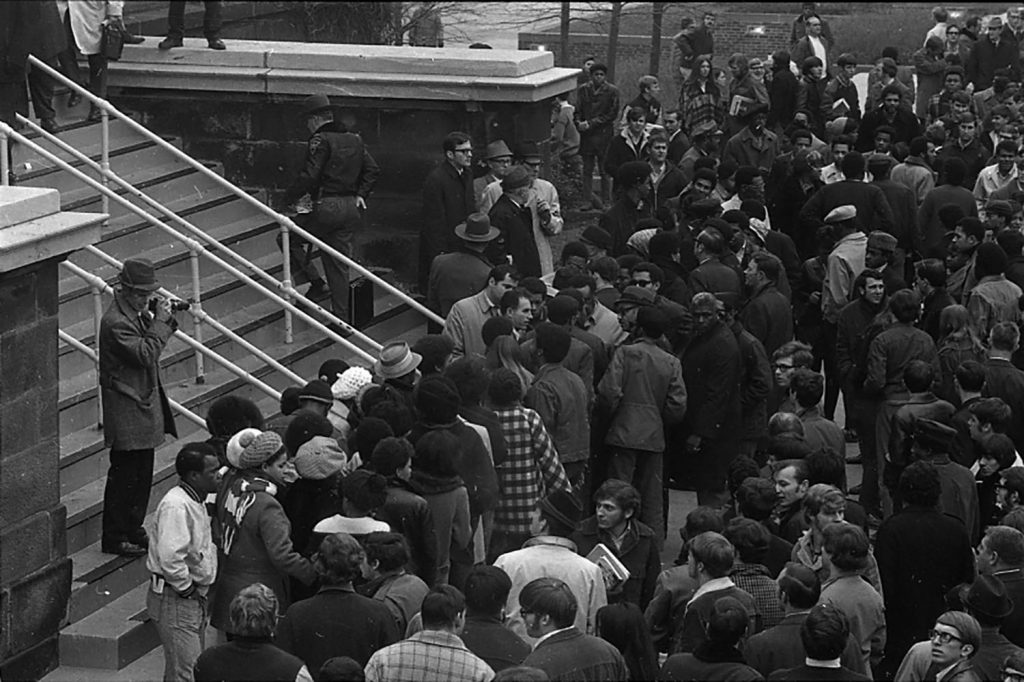
From The University of Akron Photographs Collection in Archival Services of University Libraries. Photo by Lew Tobias.
A press photographer stands on the steps of the occupied Buchtel Hall taking photographs of the crowd as administrators meet with members of BUS at the bottom of the stairs. The Akron Beacon Journal alone reportedly sent five photographers to campus to cover the event.

From The University of Akron Photographs Collection in Archival Services of University Libraries. Photo by Lew Tobias.
Numerous police officers can be seen standing on the steps of the barricaded Buchtel Hall while representatives of BUS and the University administration convene at the bottom of the steps. Onlookers, including members of the local press, stand on the parapets on either sides of the steps.

From The University of Akron Photographs Collection in Archival Services of University Libraries. Photo by Lew Tobias.
University President Norman P. Auburn looks out the window of his office on the second floor of Buchtel Hall during the takeover. Auburn and seventeen others, including Vice President Brintnall, barricaded themselves in their offices, while some were ordered by the students to leave the building, purportedly to avoid later charges of holding hostages. The president used his office phone to communicate with the authorities.
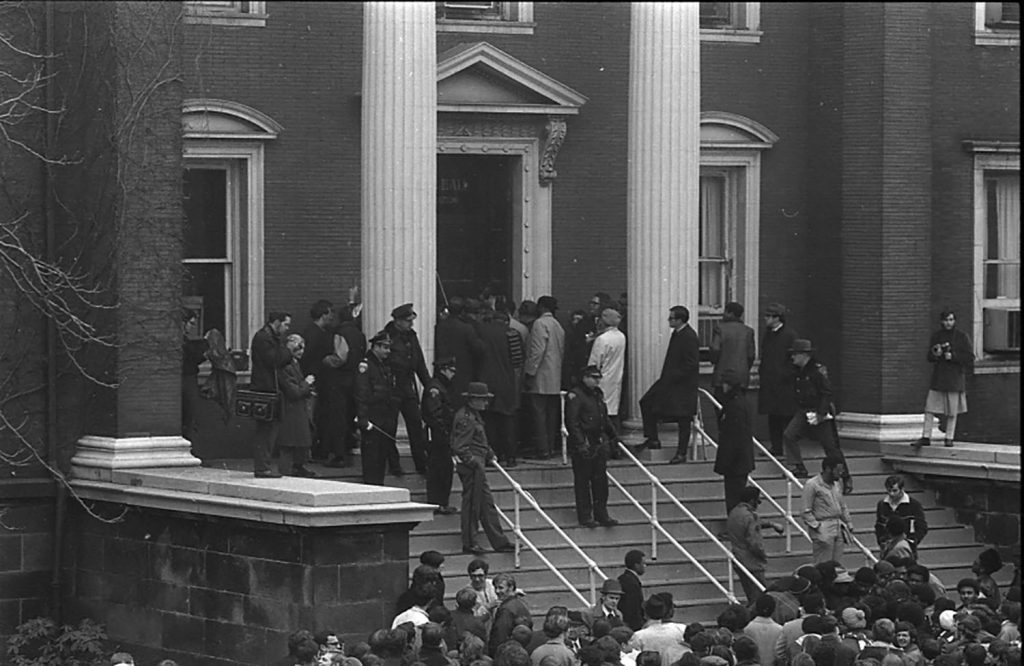
From The University of Akron Photographs Collection in Archival Services of University Libraries. Photo by Lew Tobias.
At the request of the University administration, representatives of Akron’s Black community took positions at the front door of the occupied Buchtel Hall, hoping to help negotiate a peaceful resolution with the students inside the building. This included Vernon Odom, Director of the Akron Urban League and Akron civil rights advocate (Akron’s Wooster Ave. was renamed in his honor in the early 2000s), Dr. Eldridge Sharp, former Chairman of Akron’s NAACP, and Ronald Brown, UA Student Advisor. They relayed messages through the door between administrators and the students.

From The University of Akron Photographs Collection in Archival Services of University Libraries. Photo by Lew Tobias.
The crowd begins to swell as onlookers gather on the grassy area in front of the barricaded Buchtel Hall. Approximately five hundred people including students, faculty, staff, and community members watched the events unfold from the lawn. While the crowd was mostly peaceful, a few scuffles reportedly broke out between opposing sides.
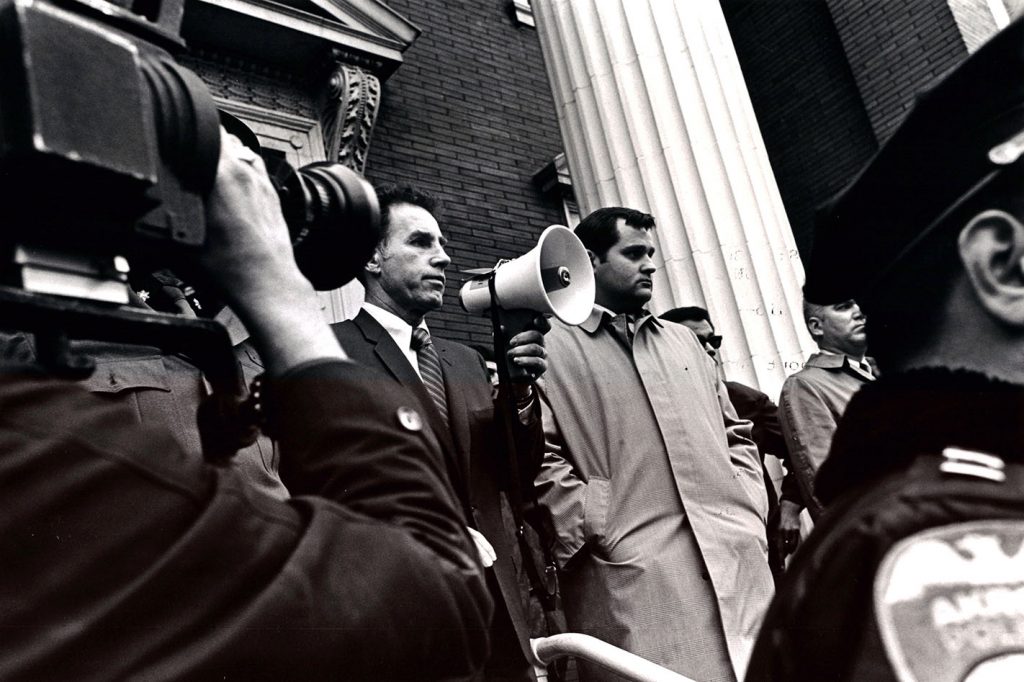
From The University of Akron Photographs Collection in Archival Services of University Libraries. Photo by Bob Wilkey.
Richard L. Hansford, Vice President and Dean of Student Affairs, address the crowd in front of Buchtel Hall. Michael Lamonica of the City of Akron Police Department stands to his left.

From The University of Akron Photographs Collection in Archival Services of University Libraries. Photo by Lew Tobias.
Administrators, negotiators, law enforcement officials, and supporters flood the steps of the building during the takeover. Black student sympathizers shouted slogans, beat on a drum, and sang songs of a revolutionary nature.
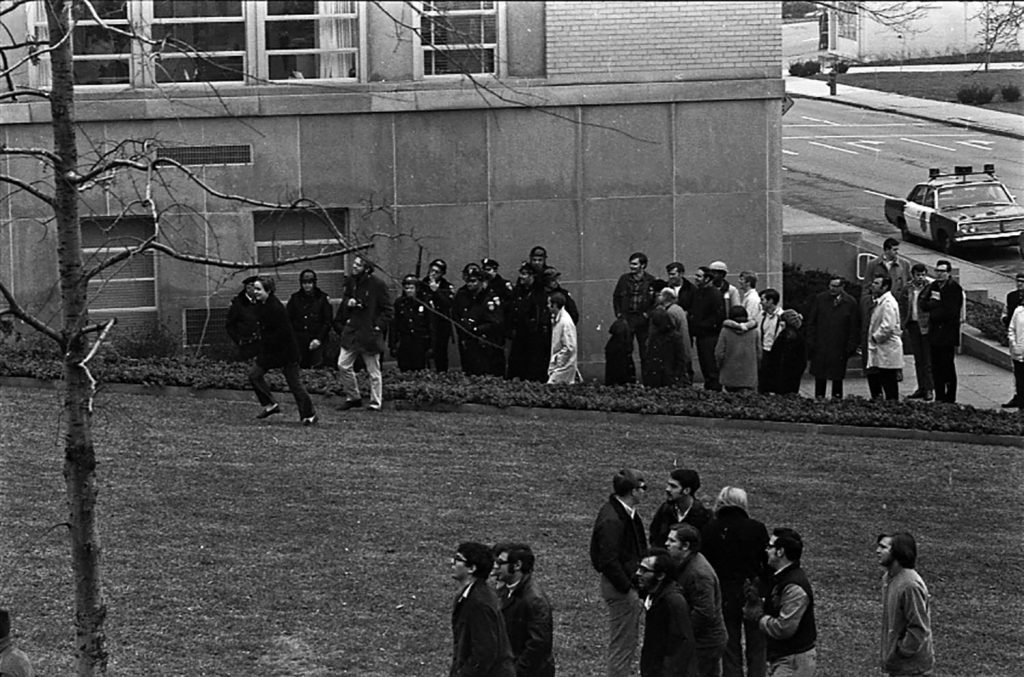
From The University of Akron Photographs Collection in Archival Services of University Libraries. Photo by Lew Tobias.
A number of onlookers–mostly students–walk towards the barricaded Buchtel Hall to watch the events unfold as numerous police officers stand next to the College of Education Building (Zook Hall). A police cruiser can be seen in the background on Buchtel Avenue.

From The University of Akron Photographs Collection in Archival Services of University Libraries. Photo by Lew Tobias.
A reporter from the local press interviews representatives of BUS, including President Bruce Conley, between the occupied Buchtel Hall and the College of Education Building (Zook Hall). During the takeover, Conley and two other BUS members remained on the outside of the building where they kept in contact with those inside via two-way radios.

From The University of Akron Photographs Collection in Archival Services of University Libraries. Photo by Lew Tobias.
An Akron Police Department van or paddy wagon sits parked on Buchtel Avenue in front of the occupied Buchtel Hall, probably in preparation for arrests. However, part of the negotiations to relinquish control of the building was that the students who took part in the takeover would not be arrested that day.
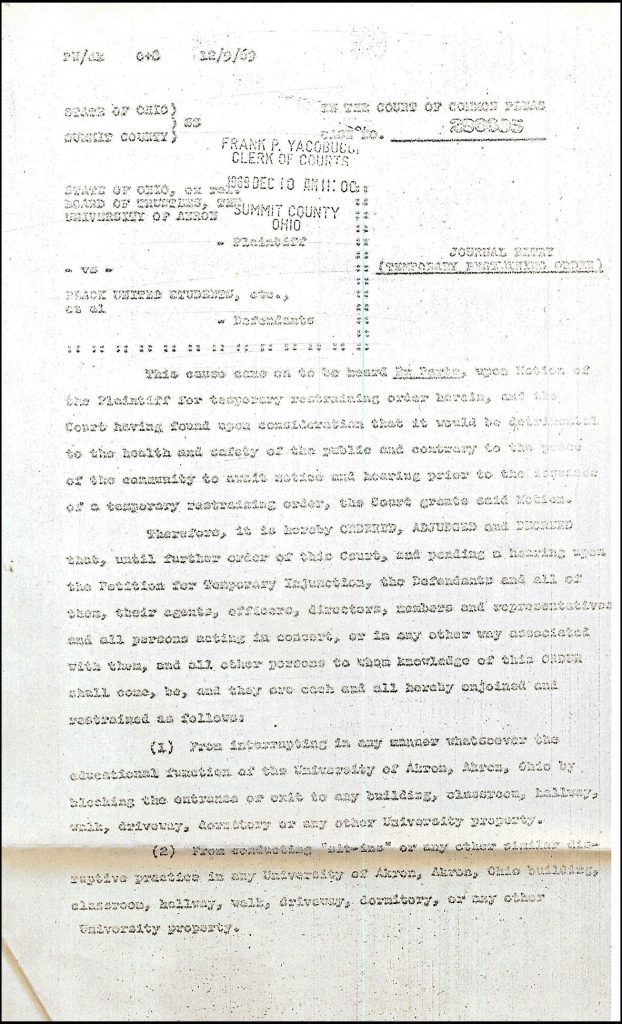
From The University of Akron Vertical File Collection in Archival Services of University Libraries
At 12:55 p.m., this court injunction “enjoining anyone from illegal occupancy and interference of lawful campus activities” was delivered to the steps of Buchtel Hall and read through the doors to the students inside by a deputy sheriff. Five minutes later the students vacated the building with their heads covered by their coats and quickly disappeared into the crowd.
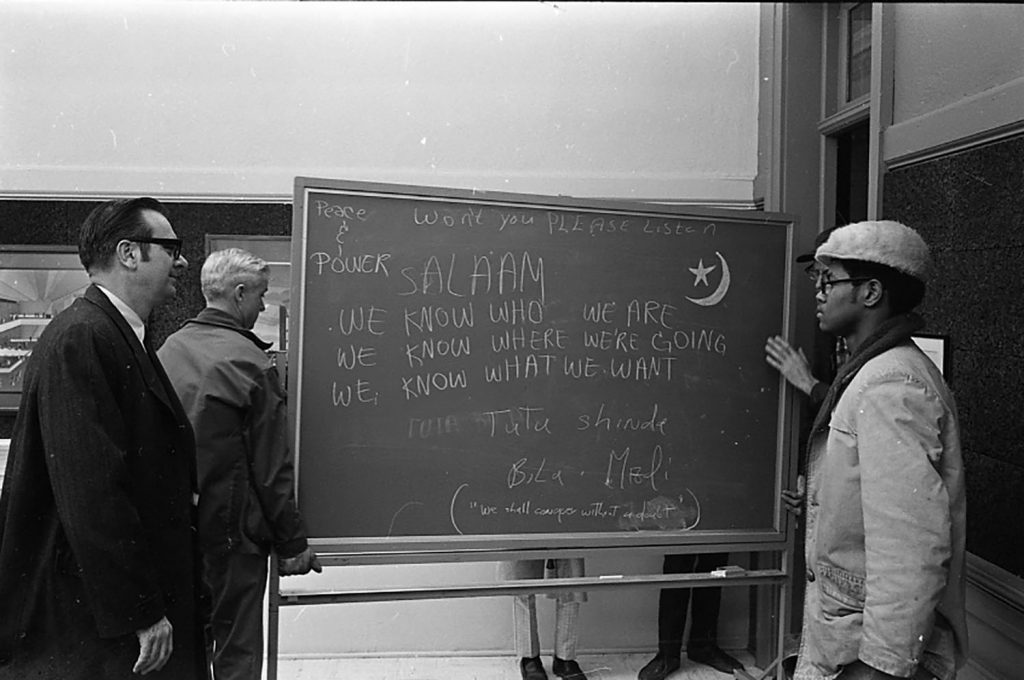
From The University of Akron Photographs Collection in Archival Services of University Libraries. Photo by Lew Tobias.
A member of BUS speaks with a University administrator inside Buchtel Hall shortly after they relinquished control of the building as police officers remove a chalk board with sayings written by the students. It states: “Peace & Power. SALAAM. Won’t you PLEASE listen? WE KNOW WHO WE ARE? WE KNOW WHERE WE’RE GOING. WE KNOW WHAT WE WANT!. Tutu shinde. We shall conquer without a doubt.” The board also includes a star and crescent, a symbol of Islam.
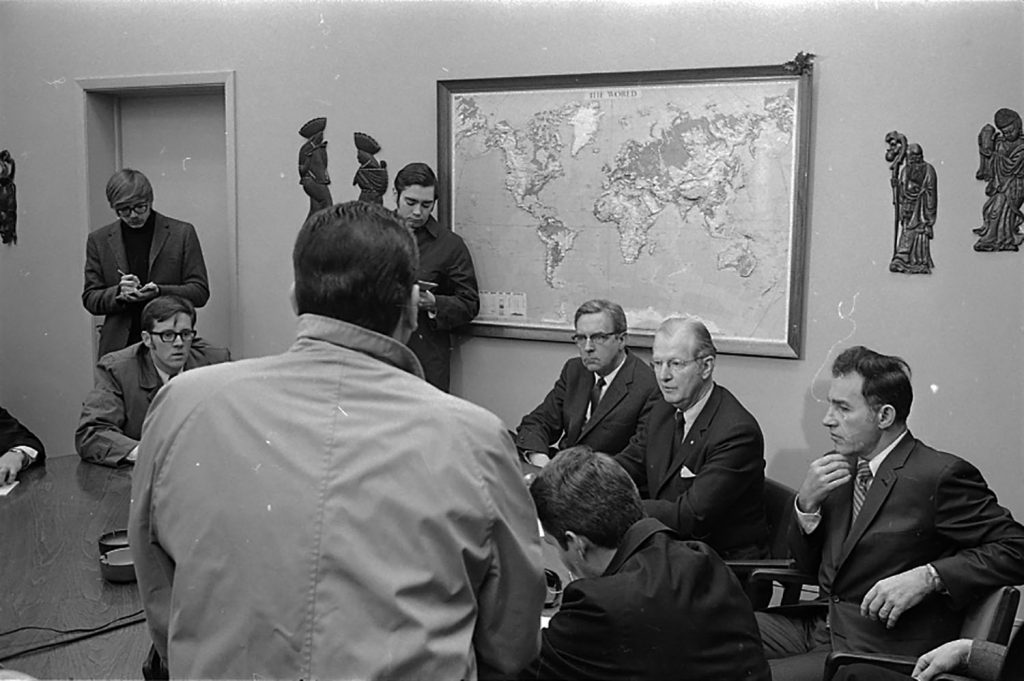
From The University of Akron Photographs Collection in Archival Services of University Libraries. Photo by Lew Tobias.
University President Norman P. Auburn and other administrators are being interviewed by the local media during a press conference immediately after the Buchtel Hall takeover ended. The press conference was given by Auburn and Governor Rhodes, who was reportedly at the conference, but is not seen in this photograph. Vice President Arthur Brintnall can be seen sitting to Dr. Auburn’s right in front of the world map.
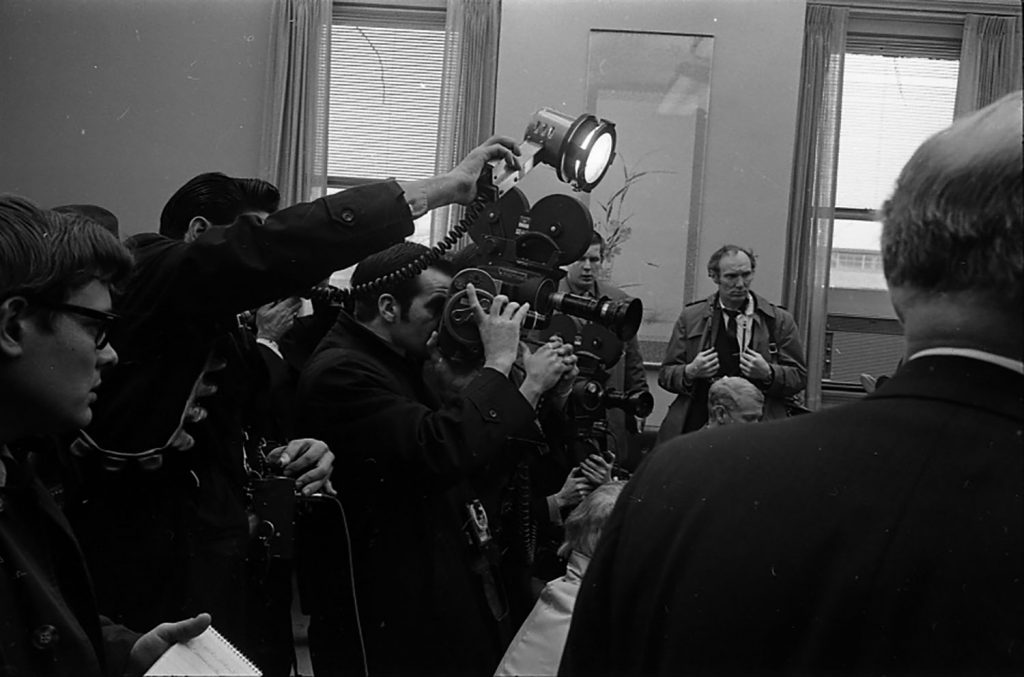
From The University of Akron Photographs Collection in Archival Services of University Libraries. Photo by Lew Tobias.
Members of the local media photograph and record University administrators during the press conference immediately following the Buchtel Hall takeover. The Akron Beacon Journal alone sent fourteen reporters and five photographers to the campus to cover the event.

From The University of Akron Photographs Collection in Archival Services of University Libraries. Photo by Lew Tobias.
President Auburn emerges from the press conference immediately following the takeover to go meet with representatives of BUS later that afternoon. The meeting between the administration and BUS to discuss the demands that day were part of the negotiations to leave the building.
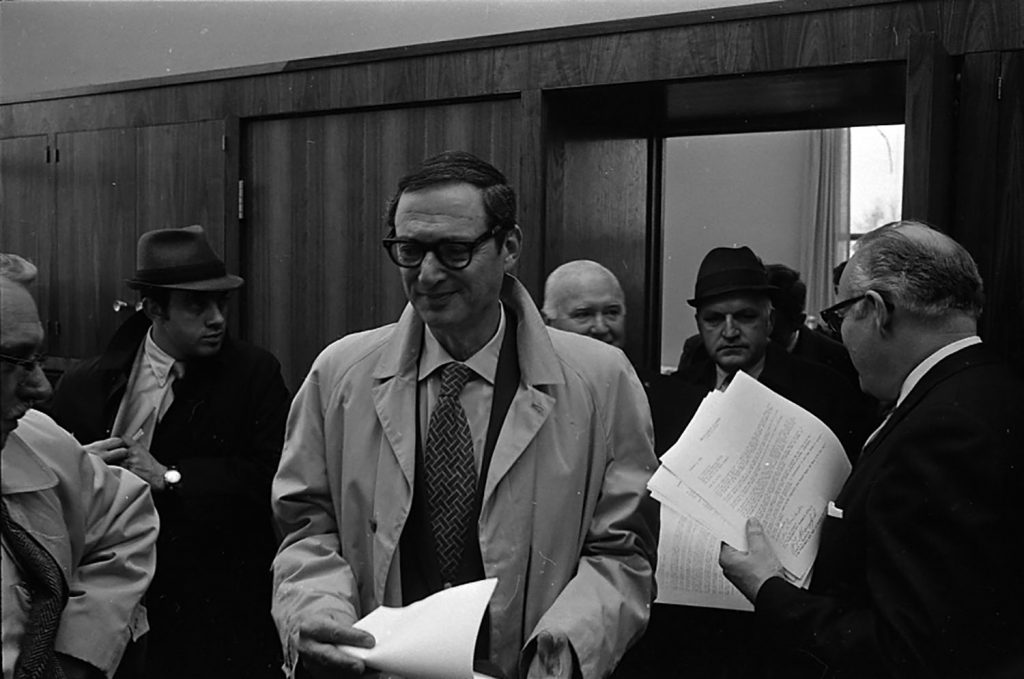
From The University of Akron Photographs Collection in Archival Services of University Libraries. Photo by Lew Tobias.
Ben Maidenburg, executive editor and publisher of the Akron Beacon Journal and member of The University of Akron Board of Trustees leaves the press conference that immediately followed the occupation of Buchtel Hall. Later, Maidenburg was lambasted in the press for exaggerating and sensationalizing the events that took place on December 10. However, Maidenburg defended himself and the paper by stating that “when reporting this incident, judgement had to be made quickly and full coverage was needed to satisfy the Black United Students, the University, and the taxpayers.”
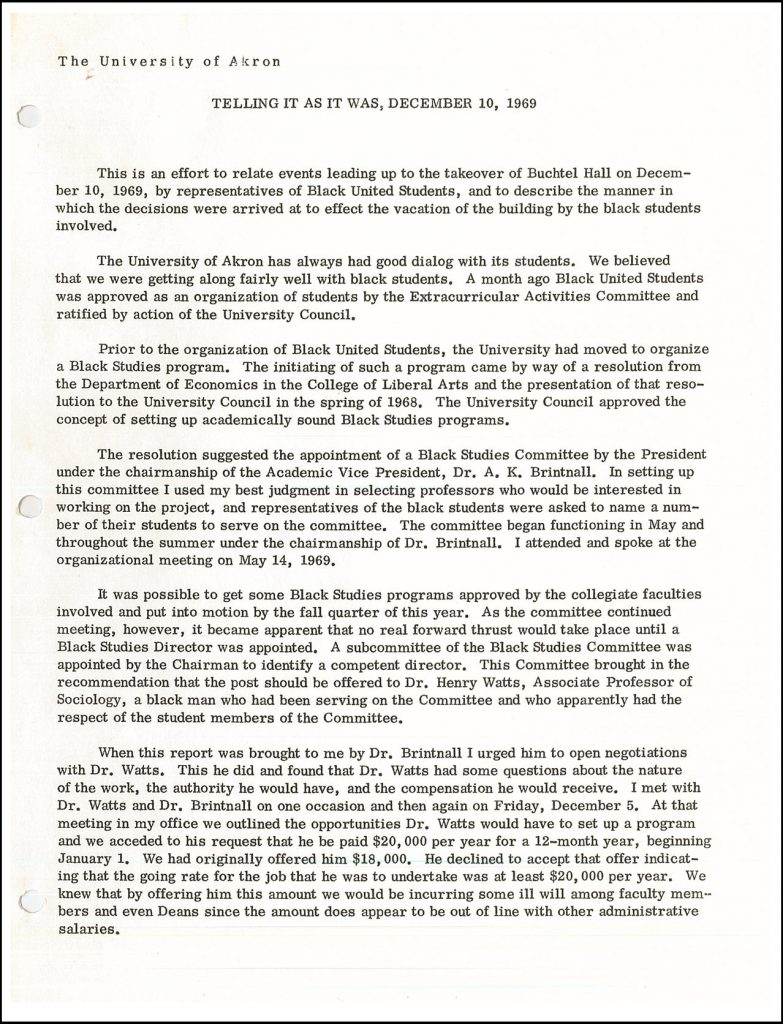
From The University of Akron Office of the President Records in Archival Services of University Libraries
This report written by President Auburn provides a detailed account of the events leading up to and including the takeover of Buchtel Hall and its aftermath. He presented the report at the regular meeting of the Board of Trustees on December 11, Auburn also presented the report to the meeting of University Council later that same day where he gave a full account of the takeover to the assembled faculty representatives. The president and administration received a vote of confidence and support from both the Board and the Council.
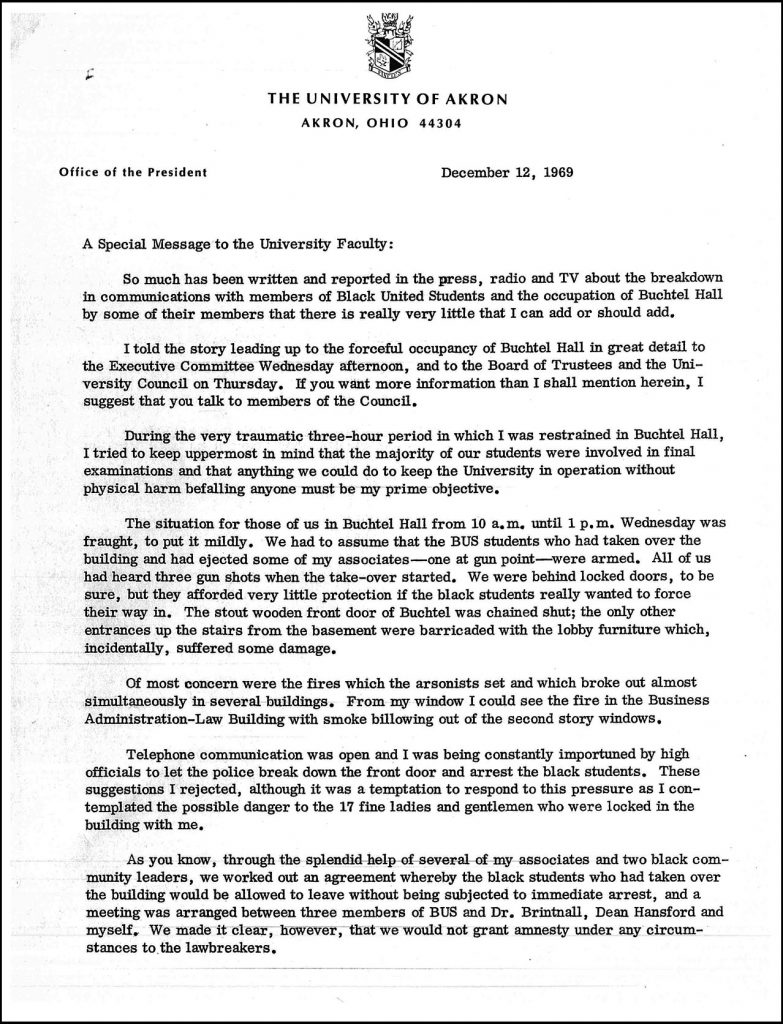
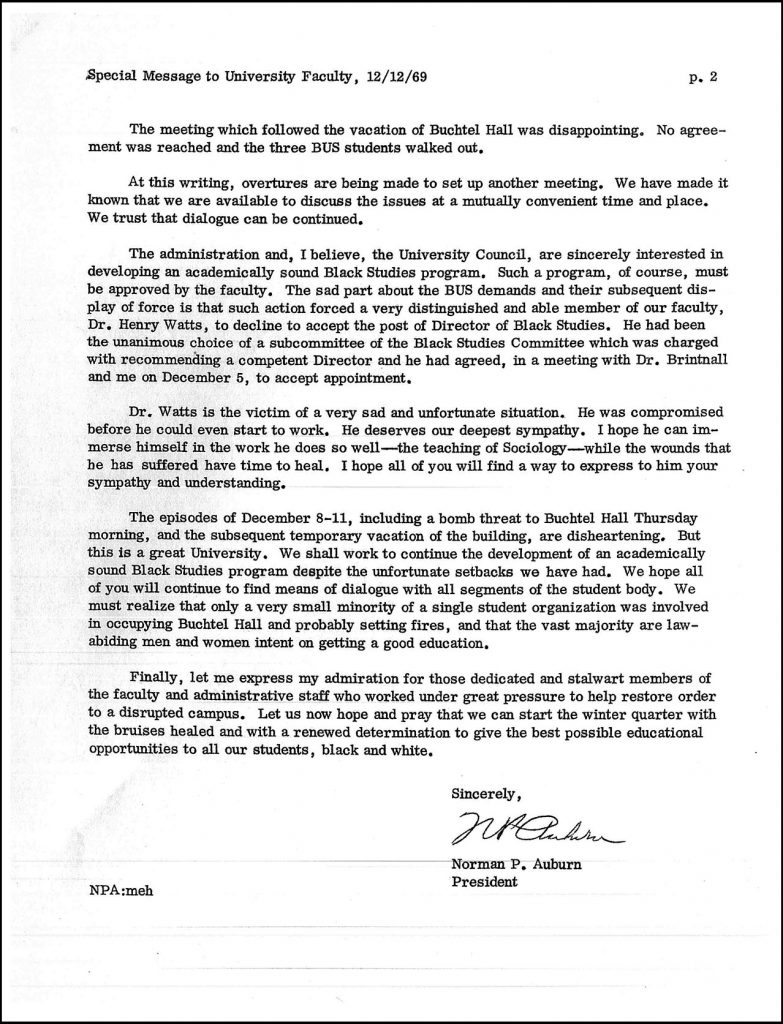
From The University of Akron Office of the President Records in Archival Services of University Libraries
Two days after the Buchtel Hall Takeover, President Auburn sent this letter to the faculty. In it he recounts the events that occurred between 10 a.m. to 1 p.m. on December 10, 1969, including his thoughts during the takeover and his decision to not allow the police to storm the building.
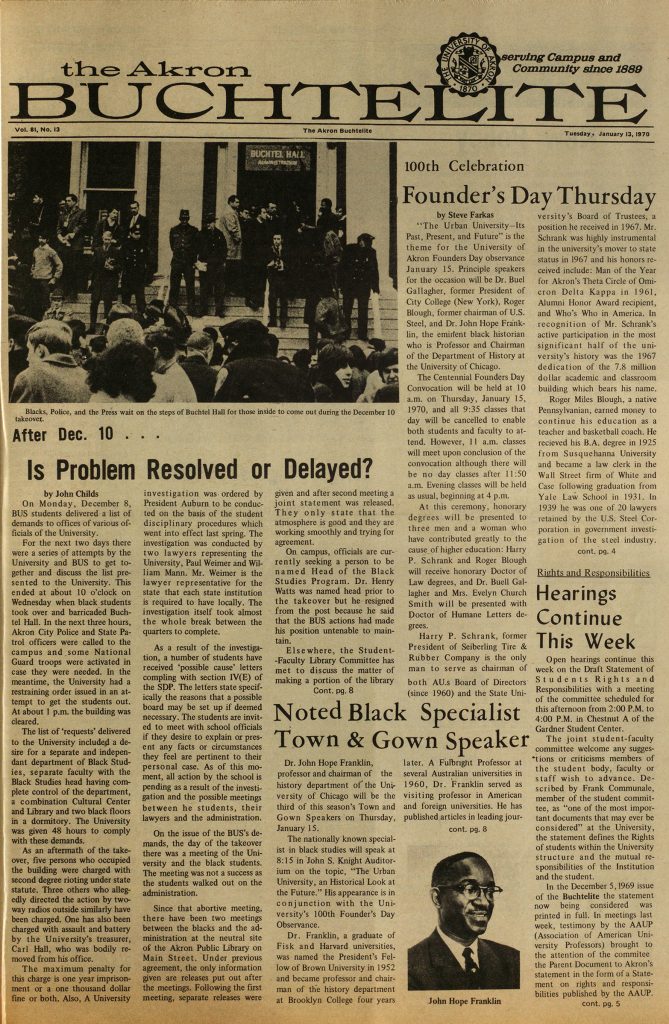
From The Buchtelite Collection in Archival Services of University Libraries
When University of Akron students returned to campus after the winter break, the Buchtelite published this article on the front page of the paper recounting the events that took place on December 10th, as The University of Akron’s Centennial year kicked off.

From The University of Akron Photographs Collection in Archival Services of University Libraries
Early in 1970, the students involved in the Buchtel Hall Takeover appeared before civil and University courts. In the Akron Municipal Court they were accused of “violent and tumultuous conduct” and all faced charges of Second Degree Riot. Three cases were dismissed, one was acquitted by a jury, and three were convicted. The students also faced the Student Faculty Hearing Board. Two received a year’s suspension while three received a quarter’s suspension. Bruce Conley was found not guilty.
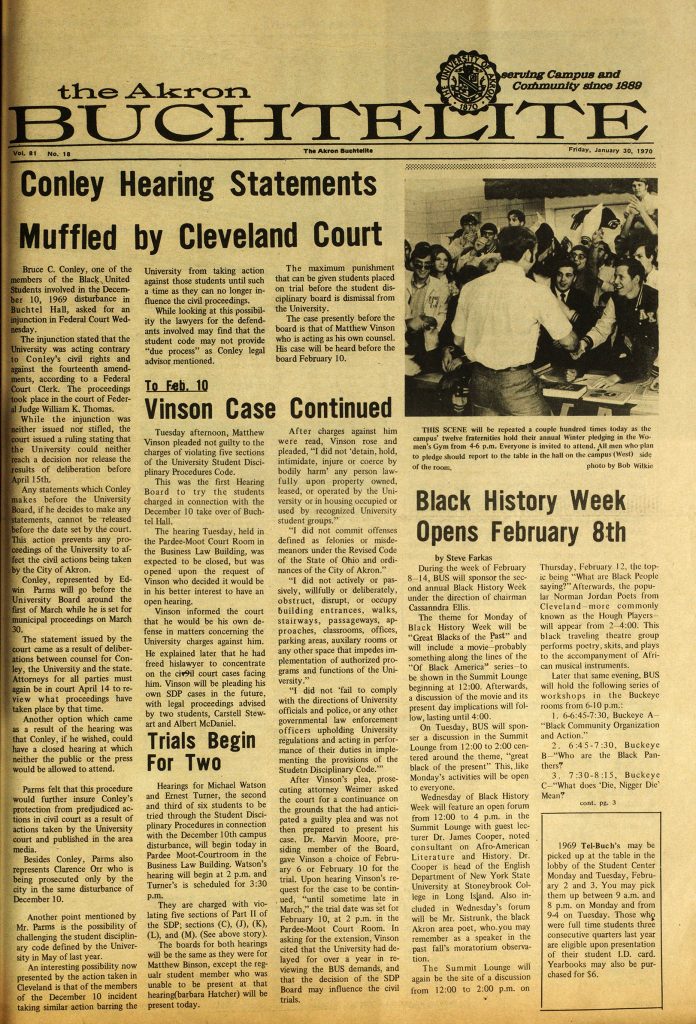
From The Buchtelite Collection in Archival Services of University Libraries
The civil trials of the students involved in the Buchtel Hall Takeover were covered in the local press, including the Akron Beacon Journal and the Buchtelite. They reported in detail what was transpiring in the court rooms. Many of the students were represented by Akron’s noted African American civil rights attorney Edwin L. Parms.
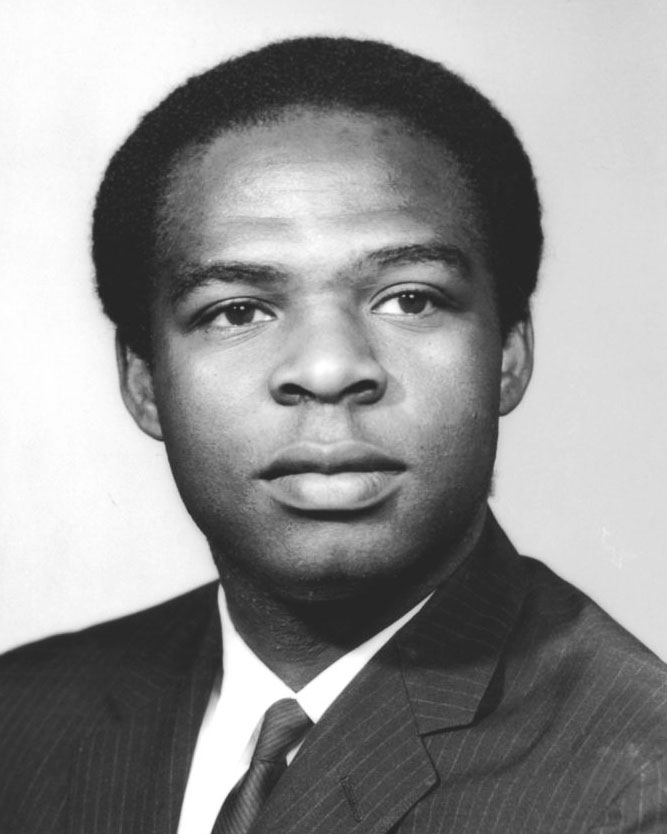
From The University of Akron Photographs Collection in Archival Services of University Libraries. Photo by Tobias Studios.
After Dr. Henry Watts resigned as the director of the Afro-American Studies Program in the wake of the takeover, the committee that selected him turned its attention to finding another candidate. In July 1970, they selected Dr. Lascelles Anderson, assistant professor of economics at the University, with John Wilson being named assistant director. Anderson, who worked at the University since 1966, received his bachelor’s degree from Howard University and his master’s degree from the New School for Social Research in New York City. After the Takeover, the University also took immediate steps towards hiring more Black faculty, and eighteen were added to the roster by the summer of 1970.

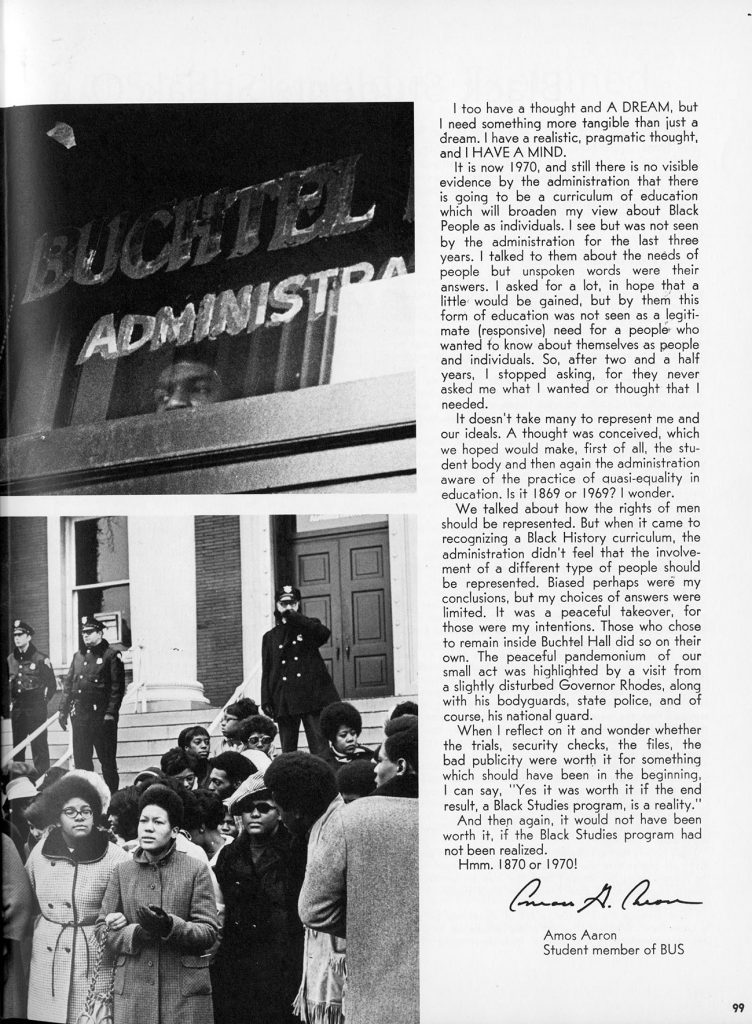
From The University of Akron Tel-Buch Collection in Archival Services of University Libraries
These pages appeared in the 1970 Tel-Buch and tell both sides of the story about the Buchtel Hall Takeover and the events leading up to the event, one by Dean Hansford and one by Amos Aaron, a student member of BUS.
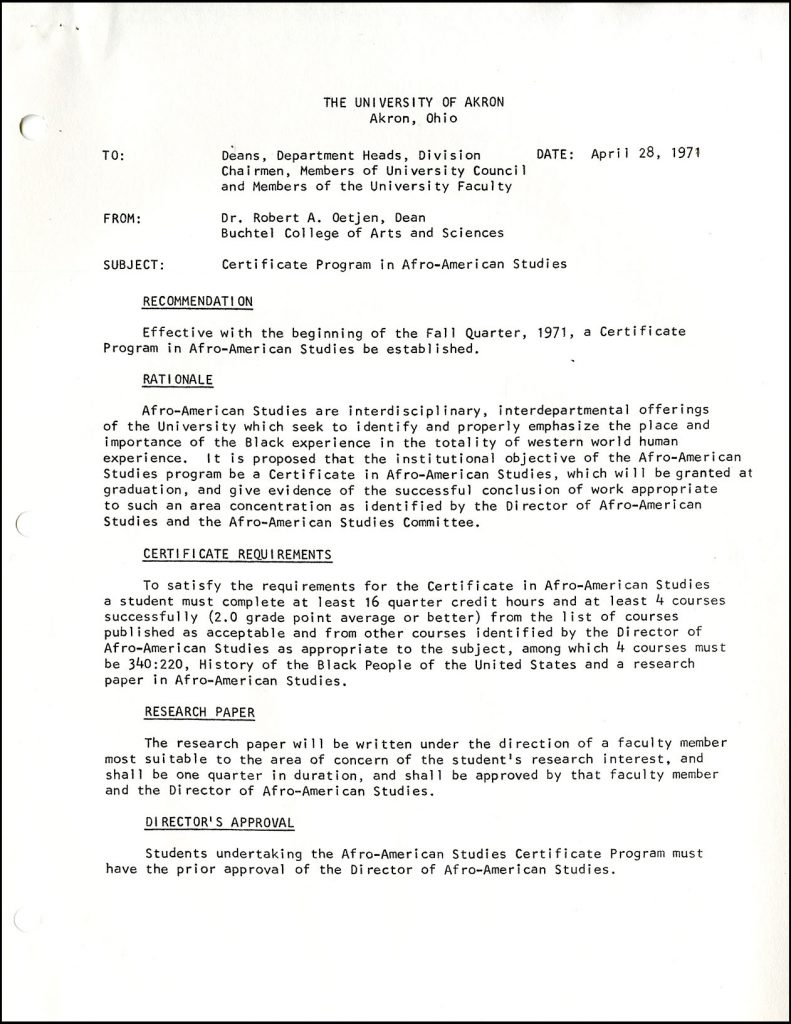
From the Black Cultural Center Records in Archival Services of University Libraries
The most significant outcome that resulted from the Buchtel Hall Takeover was the creation of a Black Studies Program, which by 1971 was renamed the Afro-American Studies Program. This memo from Dr. Robert A. Oetjen, dean of the Buchtel College of Arts & Sciences to deans, department heads, University Council, and faculty states that the program, which was not a degree but a certificate, became effective with the start of the Fall quarter in 1971. The letter also outlines the curriculum and requirements of the program.
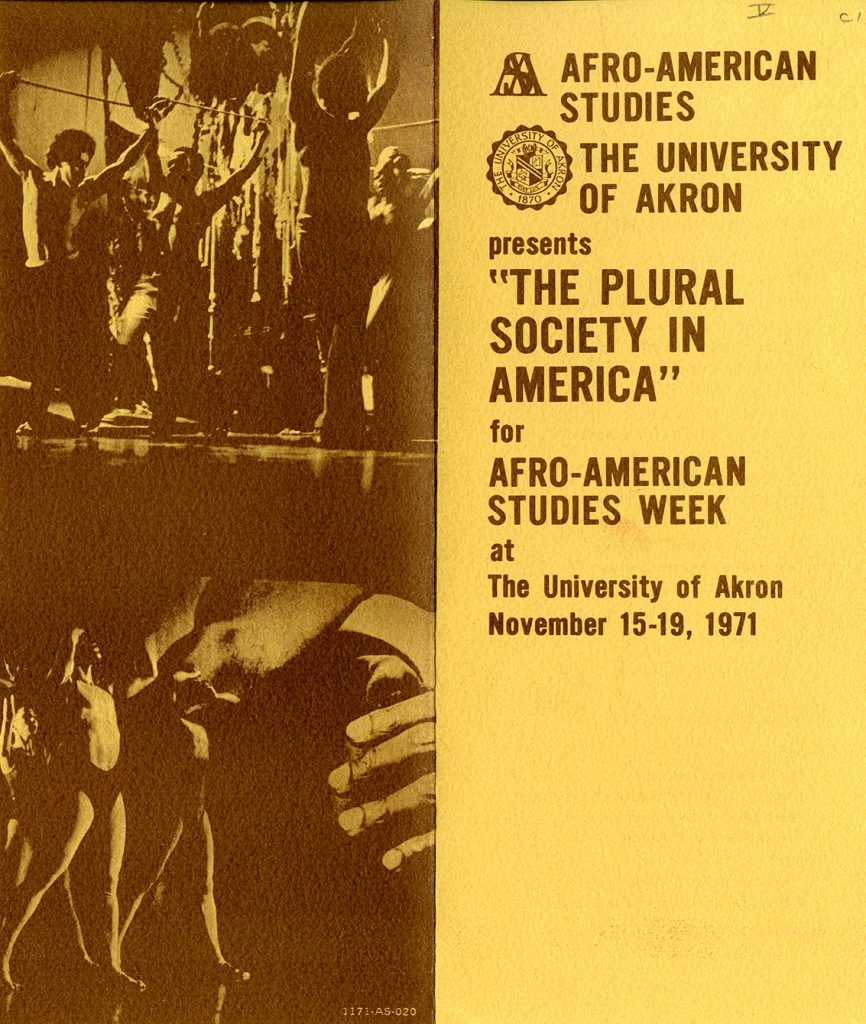
From the Black Cultural Center Records in Archival Services of University Libraries
By the end of the Fall quarter 1971, less than three months after the Afro-American Studies Program started, the program was already sponsoring events, including Afro-American Studies Week. The week long events included films, art, lectures, and cultural events that focused on Black history and culture.

From the Black Cultural Center Records in Archival Services of University Libraries
Another important result of the negotiations following the takeover of Buchtel Hall was the creation of a Black Cultural Center (BCC). As mentioned in this brochure, the BCC was established in September 1973 to develop programs on the Black Experience, coordinate the programs and activities of student organizations, and form a linkage with community organizations in support of Black Heritage. The BCC was located in East Hall and John Wilson was its first director.

From The Black Cultural Center Records in Archival Services of University Libraries
One of the important initiatives the Black Cultural Center coordinated was Black History Week, later Black History Month. The first Black History Week on campus was held in February 1970, just two months after the Buchtel Hall Takeover. One of its objectives was to promote learning and understanding between BUS and the University administration.
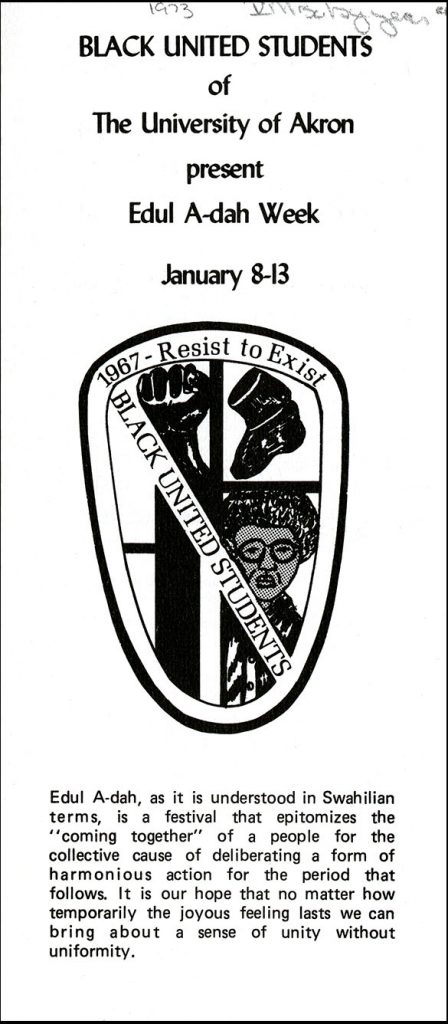
From the Black Cultural Center Records in Archival Services of University Libraries
In addition to the annual Black History Week (later Black History Month), the annual Edul A-dah (coming together) celebration came out of the Buchtel Hall Takeover. The first Edul A-dah event was celebrated in 1970, the year following the Takeover. The purpose of the event was to bring together black and white and those with opposing viewpoints in a peaceful celebration that promoted dialogue, cultural awareness, and understanding.

